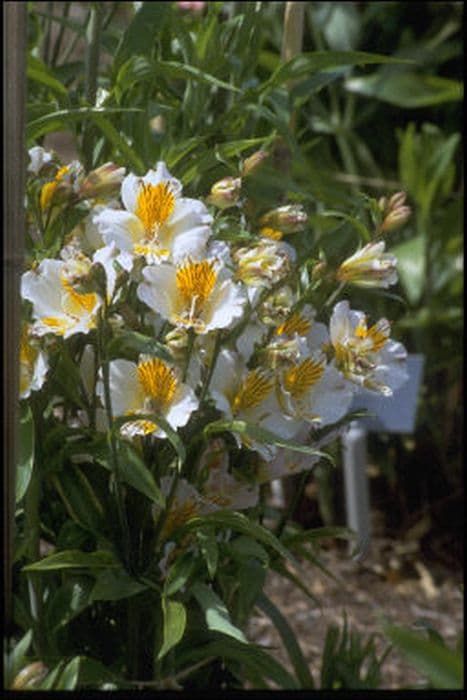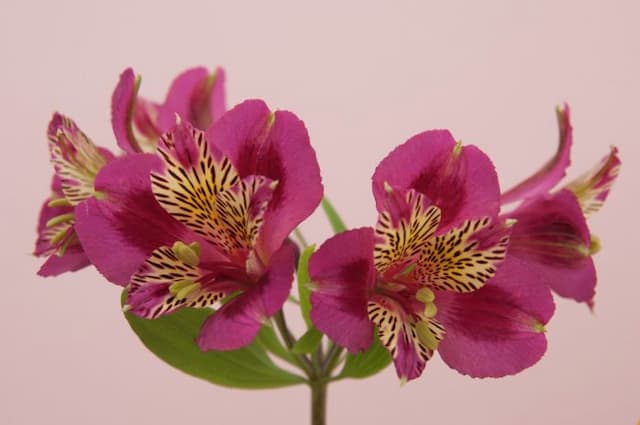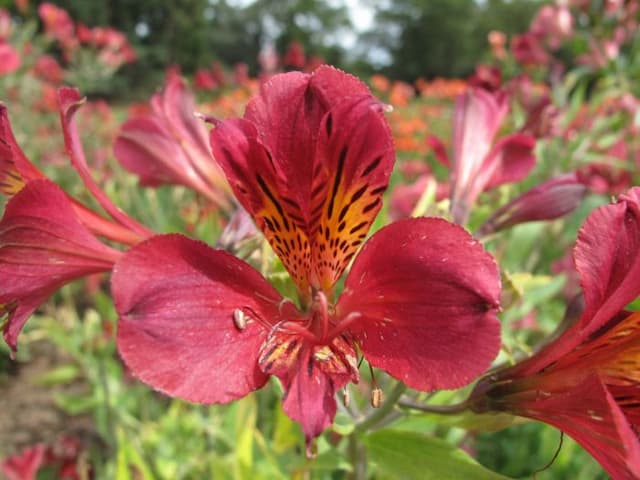Peruvian Lily Alstroemeria Princess Sara = 'Staprisara' (PBR) (Princess Series)
![Peruvian lily [Princess Sara]](/_next/image?url=https%3A%2F%2Fplants-admin.emdemapps.com%2Fimages%2Fplants%2F%2Fimages%2F604b5bc194261.png&w=3840&q=75)
ABOUT
Alstroemeria Princess Sara, which is part of the Princess Series, is a striking plant that is commonly known as Peruvian Lily or Lily of the Incas. Its appearance is characterized by a vibrant display of trumpet-shaped flowers, each boasting a unique blend of colors. The blooms typically feature a combination of soft pinks, creamy whites, and subtle yellows. These petals may display an enchanting pattern of flecks and streaks, often in darker shades of pink or burgundy, which add to the plant's visual allure. The foliage of the Peruvian Lily is composed of glossy, lance-shaped leaves that provide a lush, green backdrop for the showy flowers. The leaves are often arranged in a spiral pattern along the stems, giving the foliage a twisted or spiraled look that is quite distinctive. The overall appearance of the plant is one of elegance and beauty, making it a popular choice for ornamental gardens and floral arrangements.
About this plant
 Names
NamesFamily
Alstroemeriaceae
Synonyms
Peruvian Lily, Lily of the Incas, Parrot Lily
Common names
Alstroemeria 'Staprisara'
 Toxicity
ToxicityTo humans
The Peruvian Lily, including the variety Alstroemeria 'Staprisara', is not generally considered highly toxic to humans. However, it may cause mild irritation if ingested. The plant contains compounds that can lead to symptoms such as nausea, vomiting, or diarrhea if significant quantities are eaten. As with any plant material, individuals may have varying sensitivities, and it is always advisable to avoid ingestion and keep plants out of reach of small children who might accidentally consume them.
To pets
The Peruvian Lily can be mildly toxic to pets if ingested. The main concern is that it may cause gastrointestinal upset, including symptoms like vomiting or diarrhea. Cats and dogs that consume parts of this plant might display signs of mild discomfort, and while it is not typically considered to be severely poisonous, it's still best to prevent your pets from eating the plant to avoid these potential issues. If you believe your pet has consumed a significant amount of the plant and is showing symptoms, it is advisable to contact a veterinarian.
 Characteristics
CharacteristicsLife cycle
Perennials
Foliage type
Deciduous
Color of leaves
Green
Flower color
Mixed
Height
2-3 feet (60-90 cm)
Spread
1-2 feet (30-60 cm)
Plant type
Herb
Hardiness zones
7
Native area
South America
Benefits
 General Benefits
General Benefits- Long Blooming Period: Alstroemeria Princess Sara typically has a long flowering season, providing color and visual interest over an extended period.
- Attracts Pollinators: The vibrant flowers are known to attract bees, butterflies, and other pollinating insects, benefiting the garden's ecosystem.
- Versatility in the Garden: This plant can be used in borders, beds, and containers, making it a flexible choice for various garden designs.
- Colorful Display: The bright and varied colors of Alstroemeria Princess Sara can bring excitement and contrast to garden settings or floral arrangements.
- Cut Flower Potential: The blooms have a good vase life, making them excellent for cutting gardens and home-grown flower arrangements.
- Drought Tolerance: Once established, these plants are relatively drought-tolerant, requiring less water and maintenance.
- Hardy Nature: Alstroemeria Princess Sara is known for its hardiness, capable of withstanding various challenging growing conditions.
- Cold Tolerance: This variety can tolerate cooler temperatures, which allows it to thrive in a range of climates.
 Medical Properties
Medical PropertiesThis plant is not used for medical purposes.
 Air-purifying Qualities
Air-purifying QualitiesThis plant is not specifically known for air purifying qualities.
 Other Uses
Other Uses- Photography Prop: Alstroemeria 'Princess Sara' can provide a stunning backdrop for macro photography, featuring its intricate flowers and vivid colors.
- Educational Tool: Botany students can study the unique reproductive parts and pollination mechanisms of this species as a practical example of plant biology.
- Art Inspiration: Artists may use the striking appearance of Alstroemeria 'Princess Sara' flowers as inspiration for paintings, drawings, or fabric designs.
- Culinary Garnish: Although not commonly known for edibility, flowers of the Alstroemeria 'Princess Sara' could be used as an ornamental, non-toxic garnish to decorate desserts and salads.
- Event Theming: These flowers can be used to create a color-coordinated theme for events such as weddings, parties, or corporate functions.
- Handmade Paper: The petals and leaves, when dried, can be incorporated into the making of handmade paper for crafting and specialty stationery.
- Mindfulness Practices: Gardening enthusiasts may use the act of caring for Alstroemeria 'Princess Sara' as a form of mindfulness and stress relief.
- Color Dye: Petals can potentially be used to create natural dyes for fabric, though the specific colorfastness and vibrancy would need to be tested.
- Creative Writing Muse: The flower's beauty and exotic appearance may serve as a muse for poets and creative writers seeking floral symbolism and imagery.
- Feng Shui Use: The blossoms might be used in Feng Shui practices, as flowers are often said to contribute to a positive and harmonious energy in living spaces.
Interesting Facts
 Feng Shui
Feng ShuiThe Peruvian Lily is not used in Feng Shui practice.
 Zodiac Sign Compitability
Zodiac Sign CompitabilityThe Peruvian Lily is not used in astrology practice.
 Plant Symbolism
Plant Symbolism- Friendship: Alstroemeria, also known as Peruvian Lily or Lily of the Incas, is often given between friends to symbolize a strong bond and mutual support.
- Devotion: The intricate patterns on the petals represent a devotion to loved ones and a connectedness through adversity and triumph.
- Enduring Wealth: With its lush blooms, the Peruvian Lily is seen as a symbol of prosperity and fortune that can last through hard times.
- Achievement: The flower's resilience and ability to thrive in different environments make it a symbol of striving for success and personal growth.
- Mutual Support: Reflecting the interconnectedness of its twisted leaves, it symbolizes the importance of supporting each other in relationships.
 Water
WaterThe Peruvian Lily should be watered thoroughly, allowing the top inch of soil to dry out between waterings. In a garden setting, this might translate to approximately 1 inch of water per week, but this can vary depending on climate and soil conditions. During hotter, drier periods, you may need to water the plant twice a week, ensuring you provide enough water to penetrate the soil deeply. If grown in containers, the plant may require more frequent watering, possibly every few days, as soil in pots tends to dry out faster. Always avoid overhead watering to minimize the risk of fungal diseases and instead water at the base of the plant.
 Light
LightThe Peruvian Lily thrives in full sun to partial shade conditions. Ideally, it should receive at least 6 hours of sunlight each day. If you are growing the plant indoors, place it near a south-facing window where it will get ample light.
 Temperature
TemperatureThe Peruvian Lily prefers average room temperatures between 65 and 80 degrees Fahrenheit. It can tolerate a minimum temperature down to about 50 degrees Fahrenheit but should not be exposed to frost conditions. The plant can handle temperatures up to 90 degrees Fahrenheit, but it is important to provide adequate moisture and protection from intense afternoon sun in such conditions.
 Pruning
PruningPruning the Peruvian Lily is important for maintaining plant health and encouraging vigorous growth. After flowering, cut back spent flower stems to the base to promote additional blooming. Prune in late fall or early spring to remove any dead or damaged foliage and stimulate new growth. Pruning can be done every few months or as needed when the plant is actively growing.
 Cleaning
CleaningAs needed
 Soil
SoilPeruvian Lily thrives best in fertile, well-drained soil with a pH range of 6.5 to 7.5. A soil mix of two parts loam, one part peat, and one part sand or perlite is ideal for potting or amending garden soil.
 Repotting
RepottingPeruvian Lilies should be repotted every two to three years as they are fast-growing and can become pot-bound. Repotting is best done in the spring.
 Humidity & Misting
Humidity & MistingPeruvian Lilies prefer moderate to high humidity levels, around 40-70%, similar to their native South American climates.
 Suitable locations
Suitable locationsIndoor
Ensure bright indirect light, avoid dry air, and maintain moderate humidity.
Outdoor
Plant in partial shade, shelter from strong winds, and mulch to retain moisture.
Hardiness zone
7-10 USDA
 Life cycle
Life cycleAlstroemeria Princess Sara begins its life as a seed or dormant rhizome, planted in well-draining soil with exposure to partial to full sunlight. The rhizome then germinates or awakens in spring, sending up shoots that develop into stems with lance-shaped leaves. As the temperature warms, buds form and bloom into vibrant funnel-shaped flowers that can vary in color during late spring to summer, attracting pollinators such as bees and hummingbirds. After flowering, the plant enters a phase of seed production, where the flowers fade and seeds develop, which can be dispersed by wind or collected for propagation. During autumn, the above-ground foliage may die back as the plant enters dormancy, especially in cooler climates, conserving energy in the rhizomes underground. The cycle recommences with the return of warmer weather in spring, where new growth emerges once again from the rhizomes.
 Propogation
PropogationPropogation time
Spring-Early Summer
Alstroemeria Princess Sara, also known as Peruvian Lily, is commonly propagated through division, which is the most popular method. The best time to propagate is in late winter or early spring before new growth begins. To propagate by division, gently lift the clump of rhizomes from the ground with a shovel or garden fork, taking care not to damage the roots. Once lifted, the clump can be divided by carefully pulling apart the rhizomes into sections, ensuring that each section has at least one shoot or bud. The divided rhizomes can then be replanted in a well-draining soil mix, ideally in a location that receives full sun to partial shade. It's important to water the new plantings thoroughly to help establish the rhizomes in their new locations.







![Peruvian lily [Inca Coral]](/_next/image?url=https%3A%2F%2Fplants-admin.emdemapps.com%2Fimages%2Fplants%2F%2Fimages%2F604b5b79b85ce.png&w=640&q=75)
![Peruvian lily [Inca Exotica]](/_next/image?url=https%3A%2F%2Fplants-admin.emdemapps.com%2Fimages%2Fplants%2F%2Fimages%2F604b5ec0e34a9.png&w=640&q=75)
![Peruvian lily [Inca Milk]](/_next/image?url=https%3A%2F%2Fplants-admin.emdemapps.com%2Fimages%2Fplants%2F%2Fimages%2F604b5f14b0b6a.png&w=640&q=75)